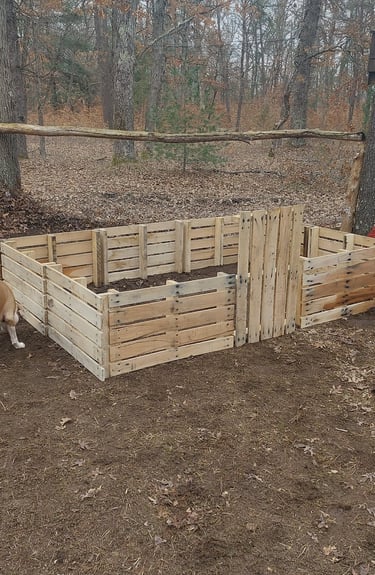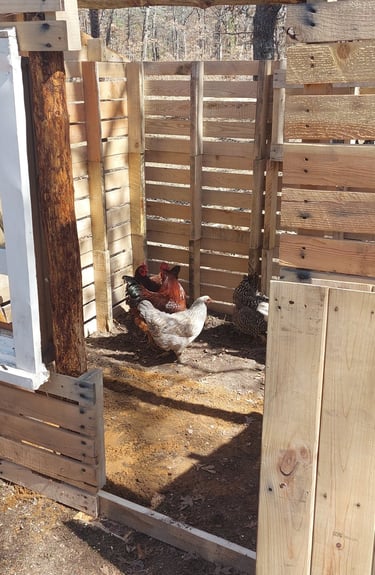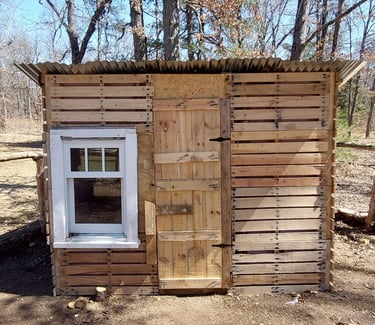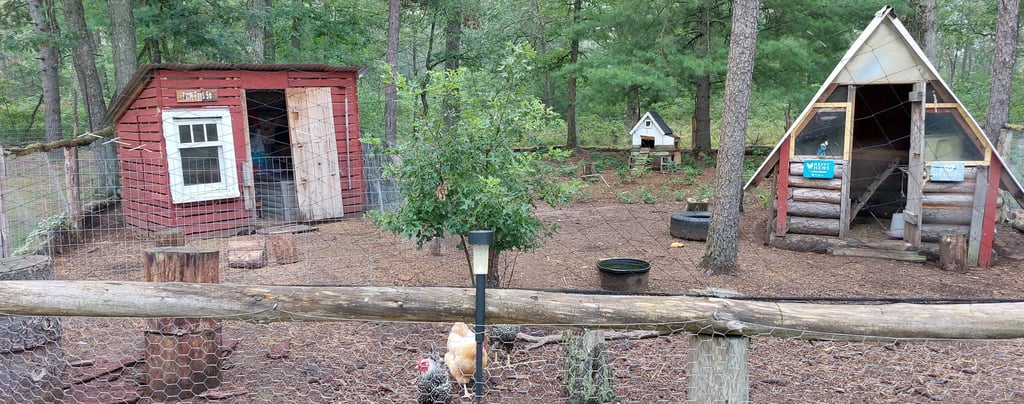Homesteading Tips, Tricks, and Ideas for a More Sustainable Life
From gardening to animal husbandry, gardening to self sufficiency, learn some simple homesteading tips and ideas for your homestead
HOMESTEADING


Introduction: A Personal Journey into Homesteading
It all started on a crisp autumn morning, the type that promises a gentle chill as the leaves crunch beneath your boots. I remember looking out at our newly acquired land, feeling a mix of exhilaration and trepidation. Homesteading was not a spontaneous decision but rather a calculated shift, a longing for simpler times, close connection to nature, and a drive towards self-sufficiency that modern life lacked. The thought of raising my own food, stewarding the land, and embracing sustainable living was compelling. I wanted a life that was purposeful and deeply connected to the earth.
One particular memory stands out as a testament to our commitment to this homesteading life—a day both challenging and utterly captivating. It was early spring, and we were setting up our first vegetable garden. The weather was unpredictable, switching between bright sun and sudden showers. As we labored to plant rows of heirloom seeds, a downpour left us drenched, mud clinging to our boots we looked at each other and couldn't help but chuckle. My hands, though tired and smeared with soil, felt a unique satisfaction—the kind that only comes from working the land. Despite the physical exhaustion, there was a quiet joy in knowing we were crafting a self-sufficient future for our family.
That day, the sky cleared just as we finished the last row of seeds. The sun kissed our faces, and a rainbow arched gracefully overhead, as if nature was offering her approval. It was there, amidst the dirt and determination, that I knew this path was the right one. Homesteading isn't merely an idyllic escape; it's a fulfilling, hands-on way of life that brings us closer to nature and to ourselves. It's a journey of learning, growing, and finding beauty in self-reliance.
Through this blog, I aim to share the essence of our homesteading experience—the tips and tricks gleaned from our adventures, the invaluable lessons learned, and the small victories that make this sustainable lifestyle so rewarding. Welcome to a journey toward a more connected, self-sufficient way of life.
Gardening Tips: Laying the Roots for Success
Starting a homestead garden is an essential step towards a more sustainable lifestyle. Whether you have a sprawling backyard or a modest urban space, the fundamentals of gardening remain the same. Selecting the right location is crucial – aim for a sunny spot, as most vegetables and herbs thrive with ample sunlight. Equally important is soil preparation. Test your soil’s pH levels and amend it with organic compost to improve fertility and structure.
Opting for heirloom seeds is a wise choice. These seeds, unlike hybrids, can be saved and replanted year after year, preserving genetic diversity. Additionally, heirloom plants often have superior flavor and resilience. Once you've chosen your seeds, companion planting can significantly enhance your garden. For instance, planting basil alongside tomatoes not only improves the tomatoes' flavor but also deters pests such as aphids. Similarly, marigolds can be planted with nearly any vegetable to help repel nematodes and other harmful insects.
Personally, my favorite plants to grow include kale, heirloom tomatoes, and chamomile. Each of these plants offers unique benefits. Kale is a hardy green that provides nutritious leaves well into the colder months, heirloom tomatoes bring a burst of flavor to any dish, and chamomile flowers can be dried to make a calming tea.
Homesteading often involves overcoming challenges. A memorable hurdle I faced was combating a persistent problem with poor soil drainage. Despite my initial efforts, my plants frequently suffered. After some research, I implemented a creative solution: constructing raised beds. This method not only improved drainage but also gave me better control over the soil quality. By integrating layers of straw, compost, and soil, I created a thriving environment for my plants.
Animal Husbandry: Partnering with Farm Animals
Raising animals on a homestead can be a profoundly rewarding experience, offering both emotional fulfillment and tangible benefits such as fresh eggs, milk, and honey. However, animal husbandry comes with significant responsibilities that must be met to ensure the health and well-being of your farm animals.
Choosing the right species and breeds is crucial. Consider your specific environment and needs when making this decision. For example, if you aim to have a steady supply of eggs, chickens are an excellent choice. Breeds like the Rhode Island Red are known for their high egg production. If you're interested in dairy, goats such as the Nubians or Alpines can provide rich, creamy milk. Bees might be an ideal choice if you're looking at honey production; the Italian Honeybee is a popular breed for its gentle nature and prolific honey production.
Constructing suitable shelters for your animals is another vital aspect of animal husbandry. Ensure that your facilities are weather-resistant and secure against potential predators. Chickens need a coop with adequate ventilation to prevent respiratory diseases. Goats require a barn with plenty of room for movement, while bees need hives positioned away from direct wind but close to flowering plants.
Daily care routines vary between species but generally include feeding, watering, and health monitoring. Chickens require a balanced diet of grains and protein to boost egg production. Goats need a mix of hay, grains, and minerals, while bees thrive on a nearby source of nectar and pollen. Regular health checks are essential; familiarize yourself with common ailments and their treatments.
Breeding practices can also be an enriching aspect of animal husbandry. Whether you're incubating chicken eggs or managing goat pregnancies, the process requires careful planning and attention to detail. Invest in quality breeding stock and always adhere to ethical breeding practices to ensure the health of both the mother and offspring.
The challenges of animal husbandry are part of what makes it so rewarding. Nursing a sick animal back to health, witnessing the birth of new life, or the simple joy of collecting fresh eggs for the first time are experiences that connect you deeply to your homestead. These moments serve as a reminder of the cycles of life and the role you play in nurturing them.
DIY Projects: Crafting and Building
DIY projects are an integral aspect of homesteading, offering numerous ways to enhance your homestead’s functionality and sustainability. One delightful and practical project to start with is building raised garden beds. Utilizing reclaimed wood or repurposed materials can not only reduce costs but also contribute to sustainability. Begin by selecting an appropriate location with ample sunlight, then construct the frames by securing the corners with galvanized screws for durability. Fill the bed with a mixture of compost and soil, providing a fertile foundation for your plants.
Constructing a chicken coop is another rewarding endeavor that can significantly boost your homestead's self-sufficiency. Focus on using natural materials like untreated wood and ensure the structure is predator-proof. Start with a solid foundation, then build the frame, creating nesting boxes and roosting bars. Remember to provide adequate ventilation and easy access for cleaning. A well-designed chicken coop not only shelters your flock but also supplies your family with fresh eggs.
Crafting homemade herbal remedies is an engaging project that underscores the essence of sustainable living. Growing your own herbs like calendula, chamomile, and lavender, and then transforming them into salves, teas, or tinctures can greatly reduce reliance on over-the-counter medications. For instance, to create a lavender salve, infuse dried lavender flowers in olive oil over low heat for several hours, strain the mixture, and mix with melted beeswax. Store in small jars for a natural remedy that's always at hand.
Throughout these endeavors, the journey often proves as valuable as the outcome. For instance, while building my first chicken coop with reclaimed wood, I encountered several design challenges. Each obstacle became a learning opportunity, enhancing both my skills and my connection to the homesteading community. Similarly, crafting my first batch of herbal remedies revealed the intricacies of plant properties and their applications.
These projects don't merely serve utilitarian purposes; they inspire creativity and promise personal growth. By engaging in such activities, you not only forge a more sustainable lifestyle but also cultivate a profound appreciation for the resilience and beauty of a self-sufficient homestead.
Sustainable Practices: Living Lightly on the Land
Adopting sustainable living principles is integral to homesteading. A significant practice in this regard is composting. By turning kitchen scraps, yard waste, and organic materials into nutrient-rich compost, homesteaders can enrich soil, reduce waste, and cultivate a more resilient garden. My first foray into composting involved a simple bin system that quickly transformed waste into valuable, organic fertilizer, significantly reducing the dependency on chemical alternatives and enhancing plant health.
Another cornerstone of sustainable homesteading is rainwater harvesting. This involves collecting and storing rainwater for irrigation and other uses. Installing a rain barrel was a game-changer, providing a consistent water source during dry spells while reducing water bills. By placing barrels beneath downspouts, rainwater was effortlessly redirected into storage containers, ready to nourish gardens and livestock.
Utilizing renewable energy sources, such as solar or wind power, is also paramount. The long-term cost savings and environmental benefits made the investment worthwhile, and the satisfaction of harnessing natural energy was unparalleled.
Reducing waste and recycling materials can also have transformative effects. Repurposing items and minimizing waste through mindful consumption can lead to a significant ecological footprint reduction. For instance, converting old pallets into chicken coops and garden beds or reusing glass jars for storage can mitigate waste while optimizing resource efficiency.
Living lightly on the land not only supports environmental stewardship but also offers financial advantages. Sustainable practices decrease expenses on utilities, fertilizers, and other resources, proving beneficial in both economic and ecological terms. Ultimately, integrating these sustainable practices epitomizes the essence of homesteading—a harmonious, self-sufficient, and responsible living approach.
Preserving and Cooking: From Harvest to Table
Homesteading offers the profound pleasure of preserving and cooking food that you have grown and harvested yourself. Food preservation methods such as canning, fermenting, dehydrating, and cold storage are essential practices that ensure the bounty of each season is enjoyed year-round. Canning fruits and vegetables in glass jars, for instance, allows you to savor the taste of summer peaches or winter squash long after their harvesting period. Fermenting vegetables like cabbage into sauerkraut not only preserves them but also enhances their nutritional value and adds a tangy zest to meals.
Dehydrating is another time-honored preservation technique that removes moisture from foods, making them lightweight and shelf-stable. Imagine biting into a slice of dried apple, still bursting with sweetness months after you've plucked it from your tree. Cold storage, such as root cellars, provides an ideal environment for storing hardy vegetables like potatoes, carrots, and onions, maintaining their freshness well into the off-season. Each of these preservation methods allows homesteaders to make the most of their harvests, reducing waste and ensuring a steady supply of nourishing food.
Among the many joys of homesteading is the ability to prepare and enjoy meals from the food you’ve preserved. A favorite recipe that comes to mind is a hearty vegetable stew, made with canned tomatoes, dehydrated mushrooms, and fresh herbs from the garden. The flavors meld together beautifully, creating a dish that’s both comforting and nutritious. The satisfaction derived from such meals transcends the act of cooking, offering a deeper connection with the food and its origins.
One particularly memorable meal was a family gathering where we enjoyed a spread of home-cooked dishes, all made from our own produce. The centerpiece was a roasted chicken, accompanied by sides of pickled beets, fermented sourdough bread, and a blueberry pie crafted from dehydrated berries. As we shared stories and laughter around the table, it was evident that homesteading had not only provided us with food but also with moments of joy and togetherness. The sense of accomplishment and harmony felt when sharing such meals with loved ones underscores the profound impact homesteading can have on creating meaningful connections and lasting memories.










I upcycled free pallets that were going to get thrown away into a functional chicken coop. The window was sitting out by the trash as I was driving down the road and knew it would be a perfect fit for the pallet coop!
Support@rusticrootshomestead.com
© 2024 Rustic Roots Homestead - All rights reserved.
